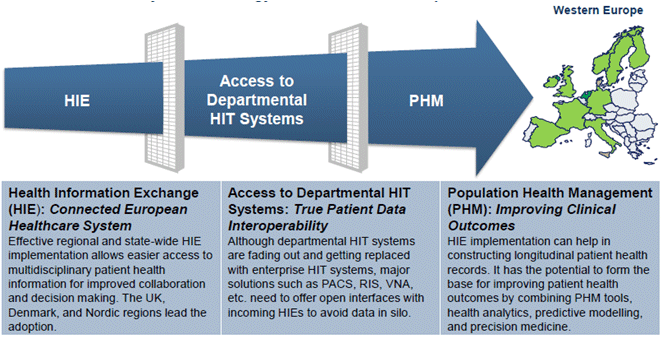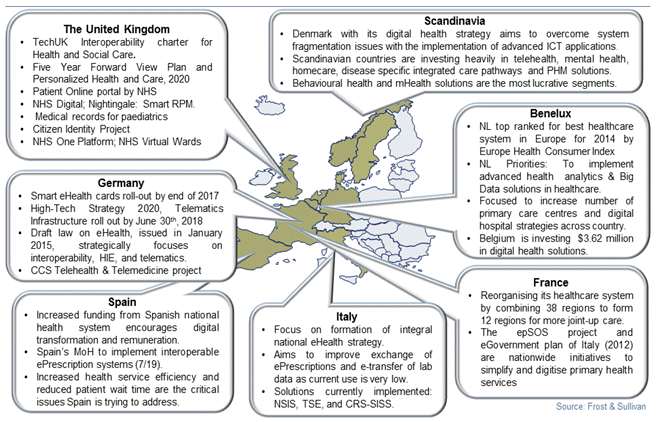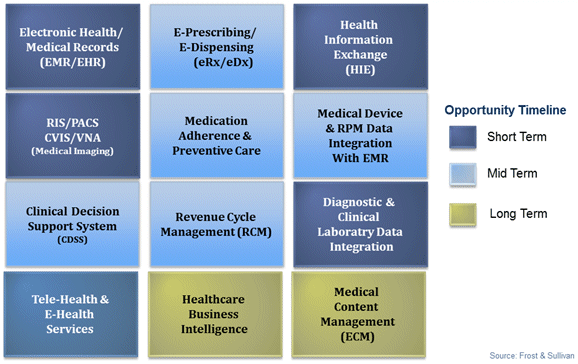The Digital Transformation of Various Health Services and Vision for Connected Healthcare Systems by 2020
Healthcare in Western Europe is changing radically as a result of varying demographics, rise of chronic diseases, and mounting financial pressure on health systems to control overall healthcare expenditure. Over the last decade, healthcare digitization initiatives have been playing a pivotal role in expanding access to quality healthcare in Western Europe through strategic investments in projects, aligned to countries’ national electronic health (eHealth) agendas. The paradigm shift from provider-centred healthcare to patient-centred healthcare has brought about a significant revolution in the way digital health strategies and services are rolled out. Healthcare regulatory bodies in each country play a critical role in developing the right systems, strategies and processes to maximize care delivery with the highest quality patient care experience.
Today, most countries in Western Europe have policies or strategies outlining eHealth objectives, implementation goals, and a future roadmap for scaling and adding new healthcare services. Countries such as the United Kingdom, Germany, the Netherlands, Sweden, Denmark, Norway, and Finland that have more advanced healthcare ICT infrastructure are beginning to deploy next-generation health informatics applications to improve patient-centric care. Some of the priority areas for future eHealth investment opportunities include: interoperable electronic health records, cloud computing, migration to Web-based applications, smart monitoring solutions for the high-acuity care setting, electronic prescribing, document management, clinical noting, integrated vital sign observation systems, healthcare mobility applications (deploying mobile device management (MDM) and bring-your-own-device (BYOD) program), data centre consolidation; enhanced clinical compliance, and disaster recovery to ensure business continuity. This transformational shift has led to the launch of following programs and initiatives such as
- National Programme for IT by the National Health Services in the United Kingdom
- TechUK’s Interoperability Charter for Health and Social Care to streamline healthcare data interoperability needs
- Germany’s High-Tech Strategy 2020
- Supported launch of the eHealth card in Germany (known in other nations as medical smart card)
- Integrated Care pathways for chronic disease conditions across various countries
- A Horizon 2020 (biggest EU Research and Innovation programme) project Nightingale seeking to develop smart patient monitoring with wireless and wearable technologies that can be integrated into clinical decision support systems
The Western Europe Healthcare IT market, despite its growth potential, is challenged by current healthcare system fragmentation, ageing IT infrastructure, absence of interoperability standards, the presence of legacy healthcare IT systems in huge numbers, and concerns surrounding patient health information privacy which prohibits the adoption of advanced paperless systems.

Overall eHealth Strategies across Western Europe:

Regional Trends & Industry Highlights – Healthcare IT, Western Europe

Western Europe Top 6 eHealth Trends
One of the transformative shifts that can be seen is the advancement in information and communication technologies (ICT) providing unprecedented opportunities to improve public health and social care systems worldwide. In Western Europe, the United Kingdom is one of the mature markets for eHealth systems with huge investments in healthcare IT infrastructure and data interoperability standards. The National Health Services (NHS) UK is all set to launch interactive health portals (NHS Choices & Patient Online) to provide individual’s access to their general physicians (GP) records, empowering healthcare consumers to take a more proactive role in all aspects of their healthcare and wellbeing. The gateway is also set to become the route for ordering repeat medication prescriptions, book appointments, register for a GP, and find listed pharmacies. This initiative can provide opportunities for Health IT vendors and software developers to launch various mHealth apps, behavioural health programs, and health analytics platforms by linking into patients’ NHS data for improved clinical outcomes.
- Healthcare Cloud Technologies: As the medical software industry matures, more products are being offered through remotely hosted deployments rather than on-premise dedicated server models. This inevitable shift to cloud based digital health services will replace the costly and insecure data centers that most providers are currently operating. Providers in Western Europe are transitioning to cloud based care management systems such as hospital information systems (HIS), ambulatory care management systems, patient management systems (PMS), electronic medical/health records (EMR/EHR), electronic prescribing that are expected to drive the industry growth over the next 2-3 years. A few vendors also offer hybrid cloud models with various advantages, such as offsite backup, disaster recovery, high resource availability and mobile device security and support.
- Healthcare System Integration & Interoperability Services: The healthcare systems integration market is expected to see healthy growth in the Western Europe. Integration and interoperability services are extensively used in several applications including medical record systems, medical device integration, laboratory integration, radiology integration, hospitals and clinics integration, telehealth portals, home health and other applications. With the emergence of Fast Healthcare Interoperability Resource (FHIR) and SMART on FHIR, the next generation standard framework created by HL7 organization, which leverages the latest Web standards and applies a tight focus on implementations set to solve the real world clinical and administrative data interoperability challenges.
- Medical Device Data Integration into Care Delivery Process: Medical device data integration with a patient’s medical record in high acuity care units allows for better patient monitoring and surveillance. Device connectivity has proven to reduce human errors while increasing operational efficiency that benefit both providers and patients. Alongside device integration, other solutions such as Early Warning Score (EWS) based clinical alarms, predictive analytics, virtual intensive care units and emergency response team alert systems can help enable clinicians to practice preventive care and improve outcomes. Many countries in Western Europe are on a mission to reduce hospital readmissions and reduce length-of-stay. Device data integration services from connected patient monitoring devices are set to become an integral part of care delivery as patients’ transition in care increasingly rely on virtual care platforms for continuous monitoring post-discharge in a patient’s home.
- mHealth & Healthcare Mobility: The convergence of mobile solutions and healthcare technologies has led to a new era of physician and patient digital engagement, with solutions such as bring-your-own-device (BYOD) and bring-your-own-application (BYOA) gaining popularity in healthcare. The growth in this sector is majorly attributed to increased penetration of smartphones, connected medical devices, health wearables, mHealth apps in the management of chronic diseases, and robust penetration of 3G and 4G networks providing uninterrupted connectivity for digital healthcare services.
- Telehealth, Telecare, and Remote Patient Monitoring Solutions: Telehealth adoption can empower patients to access healthcare from a home or community setting versus being fully reliant on brick and mortar sites including the hospital or a clinic. The ever increasing ubiquity of mHealth apps, data aggregation platforms, and cloud based data analytics solutions help to track real-time patient insights regardless of care setting.
- Medical Imaging Informatics and Image Exchange Platforms: The current digital health revolution has resulted in a scenario where the use of truly interoperable health IT systems and open standards-based medical image exchange solutions are becoming imperative to improve health outcomes. Imaging informatics has expanded to almost every clinical area following developments in imaging technologies and value-added, bundled services—such as vendor neutrality, Web-based viewing, and mobility—across virtually all departments. From radiology and cardiology to endoscopy and pathology, medical imaging utilization increased along with the rise in the number of departmental based imaging IT tools.
Future Investment Opportunities – Top 12 Healthcare IT Products & Services (2016-2020)

Conclusion
The Western European healthcare sector was long considered an impenetrable or less attractive target for IT innovations. This is definitely no longer the case and going forward, there are many fantastic areas for new opportunities in a changing healthcare environment. The European market for healthcare IT is showing significant growth mostly driven by providers aiming to enhance healthcare delivery with the introduction of a secure and cross-institutional networked infrastructure. The goal is to further reduce administrative costs, elude human errors, optimize the use of medical data, and increase quality of services by systematically swapping legacy and non-interoperable healthcare IT systems and implement systems that support open standards based data exchange.
The highest areas of growth are expected from top 5 Western European economies with the United Kingdom contributing to the highest market share followed by Germany and France. The developed economies such as the Netherlands, Denmark, Sweden, Norway, and Finland are rapidly adopting next-generation digital health platforms and mHealth solutions. By 2020, the majority of medium- and large-scale hospitals in Western Europe are expected to implement comprehensive data interoperability frameworks that enable local, state, national and cross-border health information exchanges (HIEs) facilitating nationwide exchange of health information and fuel the acceptance of digital health services. Fostering the spirit of eHealth innovations in Western European healthcare sector is the way forward to ensure quality healthcare services delivery for its citizens. Healthcare process transparency, workflow optimization through digital mean, a more skilled workforce, more efficient and sustainable health and care systems, responsive public administrations and a more patient empowerment can benefit the health systems.
This article has also appeared on www.healthmatters.org.uk



